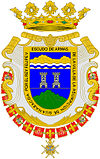Guanabacoa, Cuba
|
Guanabacoa Town of Guanabacoa |
||
|---|---|---|
| Municipality of Havana | ||

Church in Guanabacoa
|
||
|
||
| Nickname(s): Villa de Pepe Armenio | ||
 Location of Guanabacoa in Havana |
||
| Coordinates: 23°12′0″N 82°30′0″W / 23.20000°N 82.50000°WCoordinates: 23°12′0″N 82°30′0″W / 23.20000°N 82.50000°W | ||
| Country |
|
|
| Province |
|
|
| Wards (Consejos Populares) | Chivas-Roble, Debeche-Nalon, Hata-Naranjo, Mañana-Habana Nueva, Minas-Barreras, Peñalver-Bacuranao, Villa I, Villa II | |
| Area | ||
| • Total | 127 km2 (49 sq mi) | |
| Population (2004) | ||
| • Total | 112,964 | |
| • Density | 889/km2 (2,300/sq mi) | |
| Time zone | EST (UTC-5) | |
| Area code(s) | +53-7 | |
Guanabacoa is a colonial township in eastern Havana, Cuba, and one of the 15 municipalities (or boroughs) of the city. It is famous for its historical Santería and is home to the first African Cabildo in Havana. It was the site of the Battle of Guanabacoa, a skirmish between British and Spanish troops during the Battle of Havana during the Seven Years' War.
The town of Guanabacoa is found situated in the province of La Havana, some five kilometers to the southeast of La Havana (city) and south of the city of Regla. It rests on a small hill bordered by rivers.
Guanabacoa was also the home of a small community of Florida Indians, mostly Apalachees and Yamasees, who, along with Spanish forces, were evacuated from Florida in 1764, following the conclusion of the Seven Years' War.
It is unknown when the Jewish Community developed in the town of Guanabacoa. In the late 1920s Samuel Epstein, owner of Aetna Knitted Fabrics from New York’s Lower East Side, established Sedanita in rented facilities in Guanabacoa. The company imported $75,000 worth of equipment for the production of underwear, shawls, and scarves; it employed 200 workers. But, Jewish-owned businesses do not constitute a Jewish community. Sedanita moved to San José de las Lajas after it was sold to the Brandon family evidently in the late 1930s.
It is clear that earlier there were other Jewish-owned light manufacturing plants in Guanabacoa as well. In the 1930s these included the factory of Charles Shapiro. From available evidence Shapiro’s business went well. After Sedanita moved out, Shapiro bought the building that the Epstein’s rented, and used it to expand his own knitting and dying company.
By the 1940s there was a Jewish Community in Guanabacoa headquartered in the Centro Israelita at Calle Martí 252. There was also a WIZO branch. Records of the founding of the community are missing.
The Guanabacoa community apparently was business-oriented, and basing a community upon businesses is problematic. Even during the 1950s the Jewish community in Guanabacoa was in decline. It was one of the early casualties of emigration after the Castro Revolution.
Three of the greatest personalities of Cuban music were born in this town: Ernesto Lecuona, Rita Montaner, and Ignacio Villa (Bola de Nieve).
...
Wikipedia

